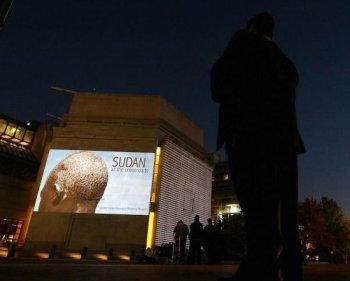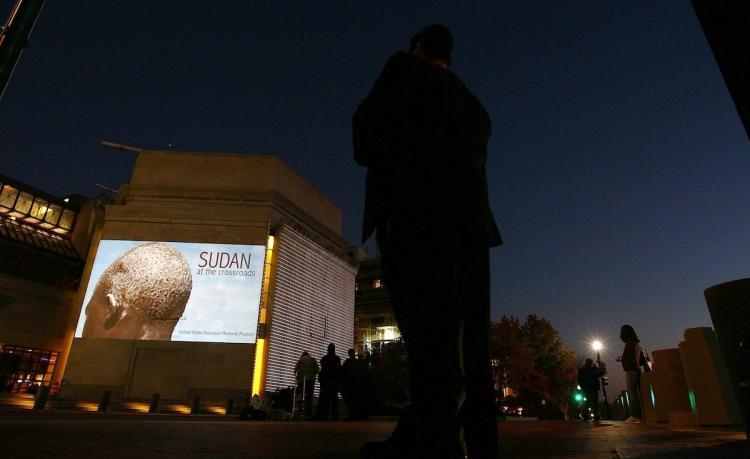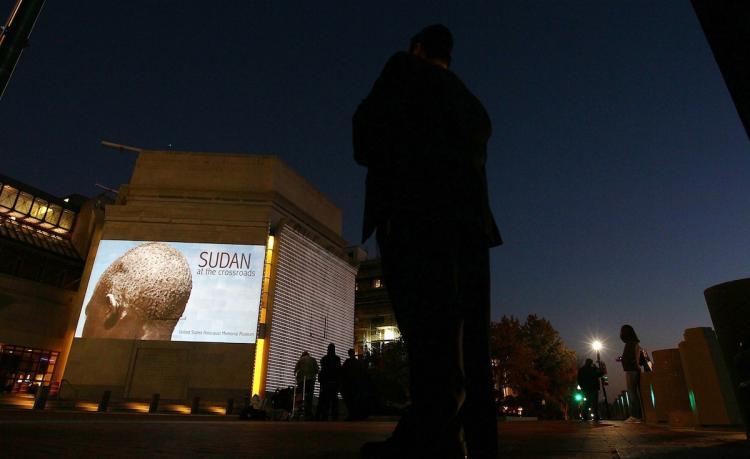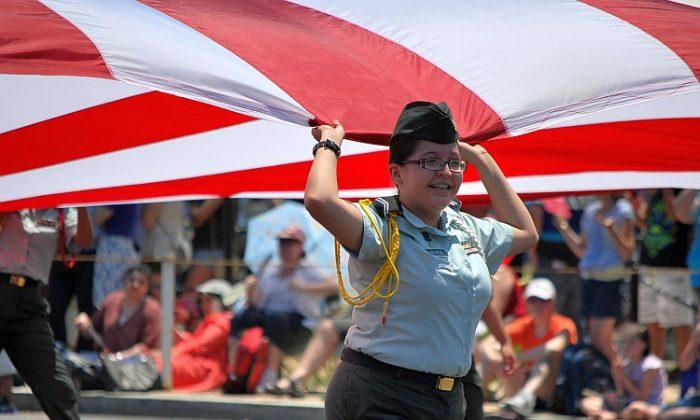WASHINGTON—In the dark of night, large photos and video from Southern Sudan were projected on two exterior walls of Holocaust Memorial Museum in Washington. The special nighttime exhibit titled “Our Walls Bear Witness: Sudan at the Crossroads” ran this week featuring the work of Pulitzer Prize winning photojournalist Lucian Perkins.
The photos are of young children, adults, and families in Southern Sudan enjoying a time of peace in their country, after having suffered through 22 years of ravaging civil war.
The goal of the exhibition was to bring attention to lives at stake as Southern Sudan prepares to vote on a referendum in January 2011 that would, if passed, make Southern Sudan its own nation independent of the Northern Sudan.
“We want you to stand with the people of Darfur, and remember that today as we speak the government of Sudan is bombing the wells in the north, they are still pursuing their strategy of defeating the rebels militarily and in the process they are killing the civilians, the innocent people of Darfur. … The government of Sudan has run out of villages to burn. … We should stop this,” said Omer Ismail, cofounder of Darfur Peace and Development and fellow at Harvard’s Carr Center for Human Rights Policy.
The photo and video exhibition documents a recent trip to Southern Sudan by Mike Abramowitz, director of the U.S. Holocaust Memorial Museum’s Committee on Conscience, and Andrew Natsios, professor in the practice of diplomacy at Georgetown University and former USAID administrator. With Lucian Perkins, the group documented conversations with survivors of war, key political leaders, and members of civil society. The group met with the president and vice president of South Sudan, six cabinet ministers in their government, representatives of nongovernment organizations, and opposition leaders. They were not permitted to visit Khartoum the northern capital of Sudan.
“Despite the violence, the hardships, and poverty there is still a lot of hope about the future, and there is just an enormous enthusiasm from everyone we’ve met here about the prospect of independence,” said Abramowitz in a video documenting their trip.
“The rebels decided to kill us, soon they decided to collect people to kill, my mother was one of them. They started beating her with an ax—my mother died at that moment. The boy came at me with a machete, he cut me on my face, my forearm, and my breast. I pretended to be dead. I saw the rebels go after my sister, they beat her so badly that her head cracked into pieces,” said Sunday, a 24-year-old woman who lives outside of Juba in Southern Sudan.
In the video installation, a young man freely plays basketball while sharing his experience of being enslaved in the north. School children in uniforms sing songs of peace—enjoying the respite from the civil war that has left 2 million southern Sudanese dead and another 200,000 murdered in the genocide in Darfur.
“To see the change in the south, to see what peace has done, what oil revenues has done in the south, warms my heart, but it also makes me very nervous about what can happen,” said Natsios at the exhibition opening.
Many in the international community view the situation in Sudan as highly volatile, with the greatest risk being a return to war between the north and south, victims once again targeted by ethnic, geographic, and cultural divides. Secretary of State Hillary Clinton has called the state of the region a ticking time bomb.
The special nighttime exhibition at the museum coincides with FotoWeek DC 2010, and an existing internal museum exhibition, “From Memory to Action: Meeting the Challenge of Genocide.” The interactive installation introduces visitors to the concept and laws against genocide and three contemporary cases of genocide, Rwanda, Srebrenica in Bosnia Herzegovina, and the Darfur region of Sudan. It poses the question to each visitor: What will you do meet the challenge of genocide?
The U.S. Holocaust Memorial Museum is a federal government funded institution, that not only remembers the Holocaust, but also features a genocide prevention task force with a mission to make genocide prevention a national priority, and to develop practical policy recommendations to enhance the capacity of the U.S. government to respond to emerging threats of genocide and mass atrocities.
The photos are of young children, adults, and families in Southern Sudan enjoying a time of peace in their country, after having suffered through 22 years of ravaging civil war.
The goal of the exhibition was to bring attention to lives at stake as Southern Sudan prepares to vote on a referendum in January 2011 that would, if passed, make Southern Sudan its own nation independent of the Northern Sudan.
“We want you to stand with the people of Darfur, and remember that today as we speak the government of Sudan is bombing the wells in the north, they are still pursuing their strategy of defeating the rebels militarily and in the process they are killing the civilians, the innocent people of Darfur. … The government of Sudan has run out of villages to burn. … We should stop this,” said Omer Ismail, cofounder of Darfur Peace and Development and fellow at Harvard’s Carr Center for Human Rights Policy.
The photo and video exhibition documents a recent trip to Southern Sudan by Mike Abramowitz, director of the U.S. Holocaust Memorial Museum’s Committee on Conscience, and Andrew Natsios, professor in the practice of diplomacy at Georgetown University and former USAID administrator. With Lucian Perkins, the group documented conversations with survivors of war, key political leaders, and members of civil society. The group met with the president and vice president of South Sudan, six cabinet ministers in their government, representatives of nongovernment organizations, and opposition leaders. They were not permitted to visit Khartoum the northern capital of Sudan.
“Despite the violence, the hardships, and poverty there is still a lot of hope about the future, and there is just an enormous enthusiasm from everyone we’ve met here about the prospect of independence,” said Abramowitz in a video documenting their trip.
“The rebels decided to kill us, soon they decided to collect people to kill, my mother was one of them. They started beating her with an ax—my mother died at that moment. The boy came at me with a machete, he cut me on my face, my forearm, and my breast. I pretended to be dead. I saw the rebels go after my sister, they beat her so badly that her head cracked into pieces,” said Sunday, a 24-year-old woman who lives outside of Juba in Southern Sudan.
In the video installation, a young man freely plays basketball while sharing his experience of being enslaved in the north. School children in uniforms sing songs of peace—enjoying the respite from the civil war that has left 2 million southern Sudanese dead and another 200,000 murdered in the genocide in Darfur.
“To see the change in the south, to see what peace has done, what oil revenues has done in the south, warms my heart, but it also makes me very nervous about what can happen,” said Natsios at the exhibition opening.
Many in the international community view the situation in Sudan as highly volatile, with the greatest risk being a return to war between the north and south, victims once again targeted by ethnic, geographic, and cultural divides. Secretary of State Hillary Clinton has called the state of the region a ticking time bomb.
The special nighttime exhibition at the museum coincides with FotoWeek DC 2010, and an existing internal museum exhibition, “From Memory to Action: Meeting the Challenge of Genocide.” The interactive installation introduces visitors to the concept and laws against genocide and three contemporary cases of genocide, Rwanda, Srebrenica in Bosnia Herzegovina, and the Darfur region of Sudan. It poses the question to each visitor: What will you do meet the challenge of genocide?
The U.S. Holocaust Memorial Museum is a federal government funded institution, that not only remembers the Holocaust, but also features a genocide prevention task force with a mission to make genocide prevention a national priority, and to develop practical policy recommendations to enhance the capacity of the U.S. government to respond to emerging threats of genocide and mass atrocities.




